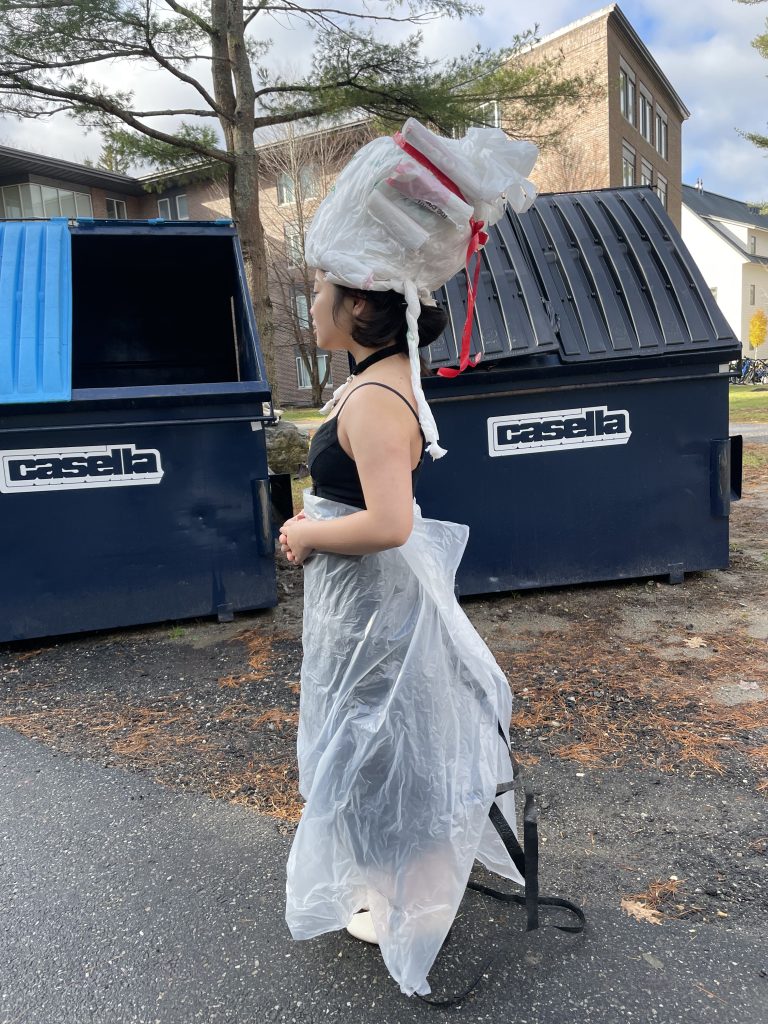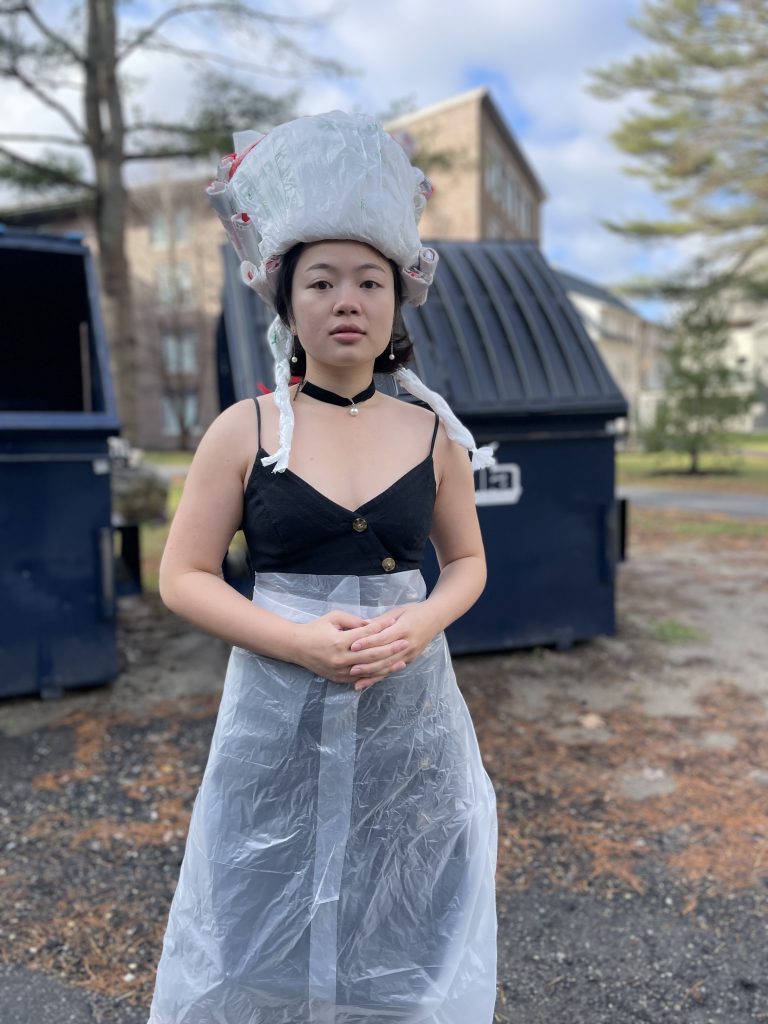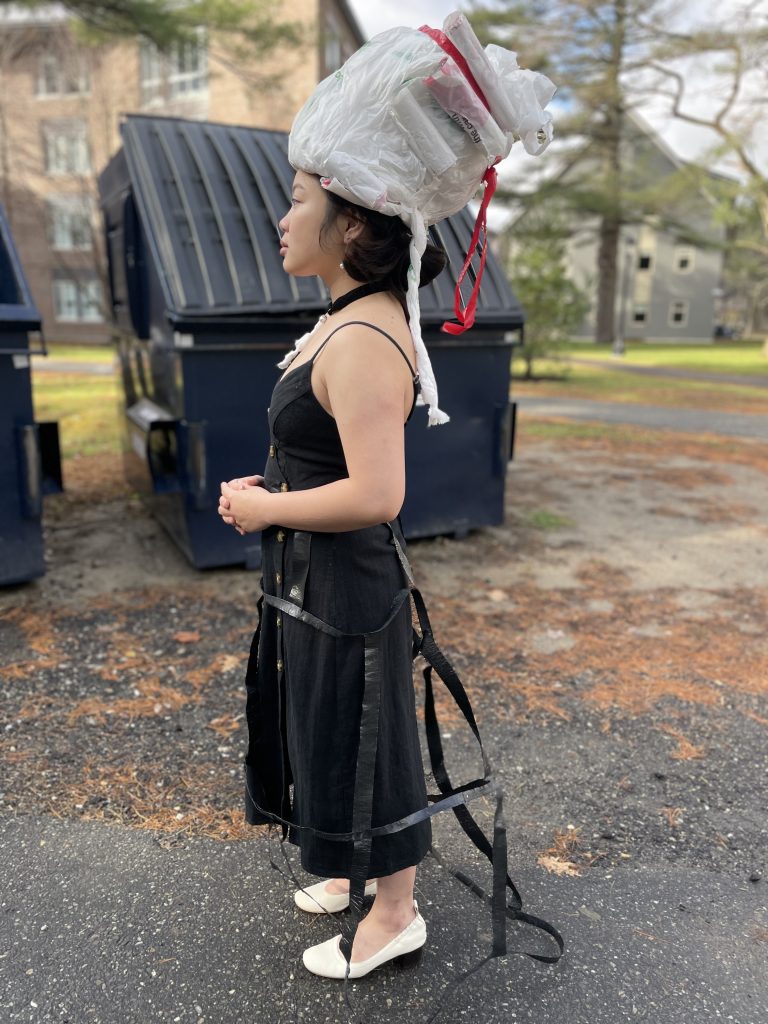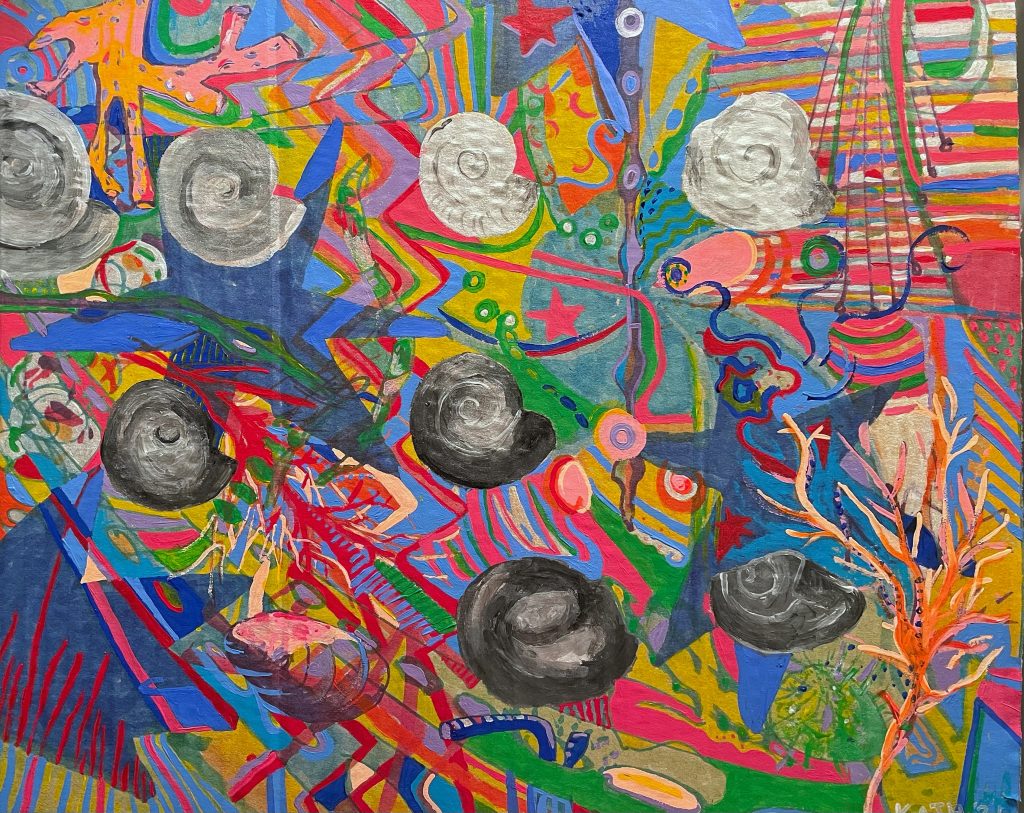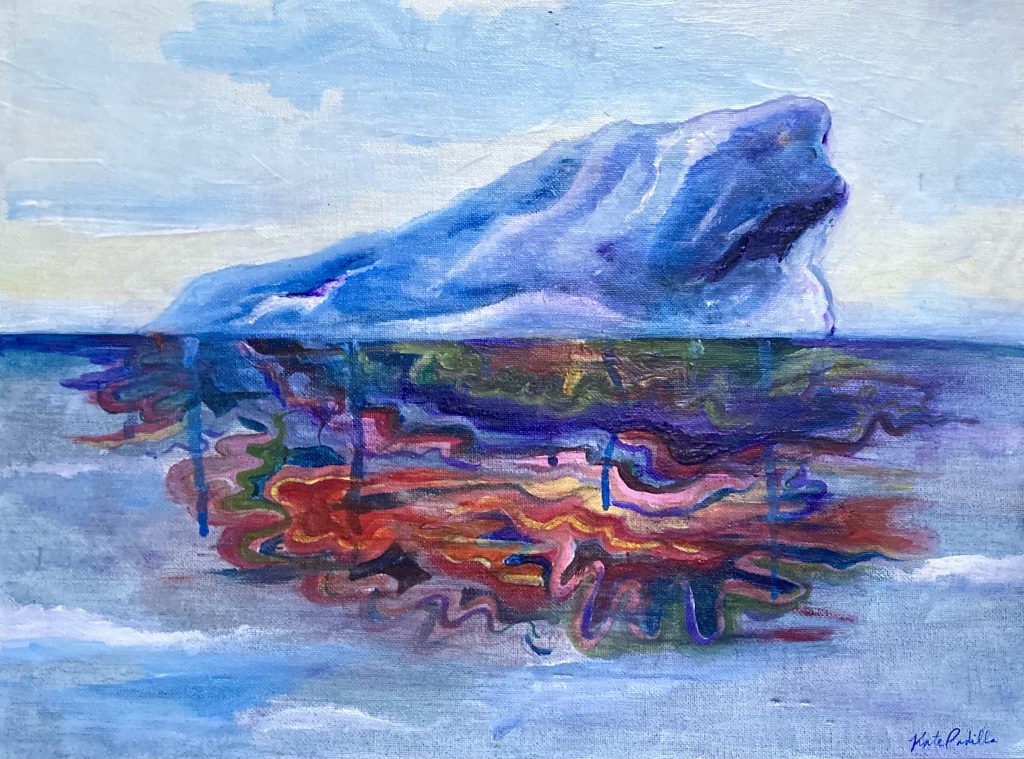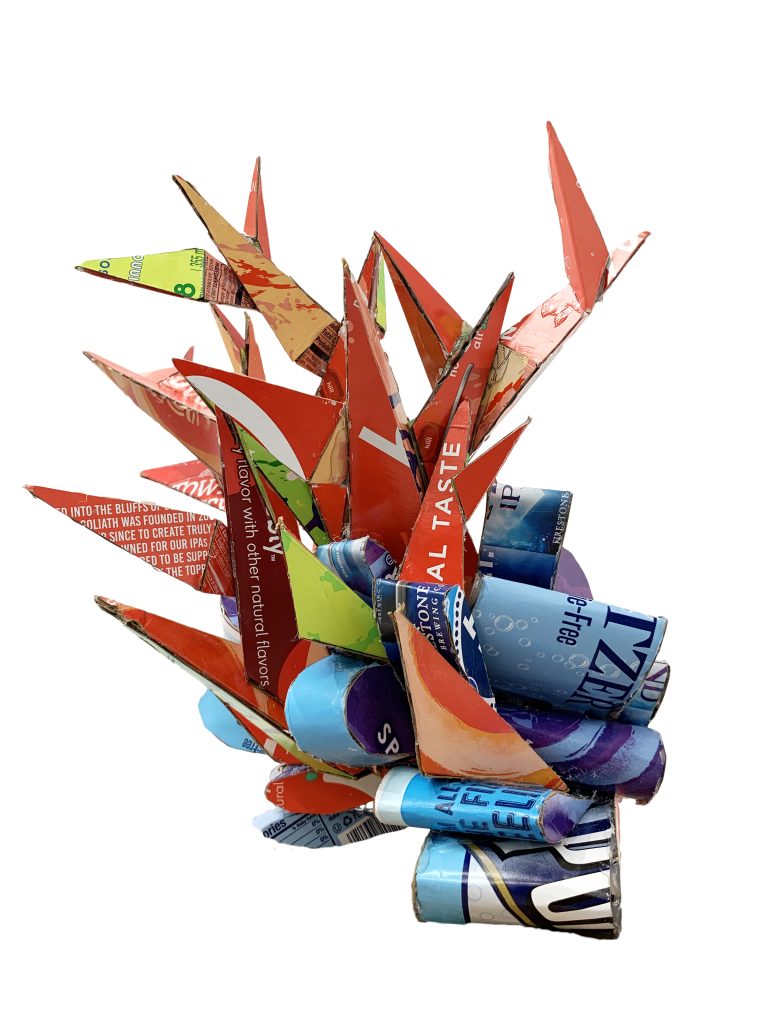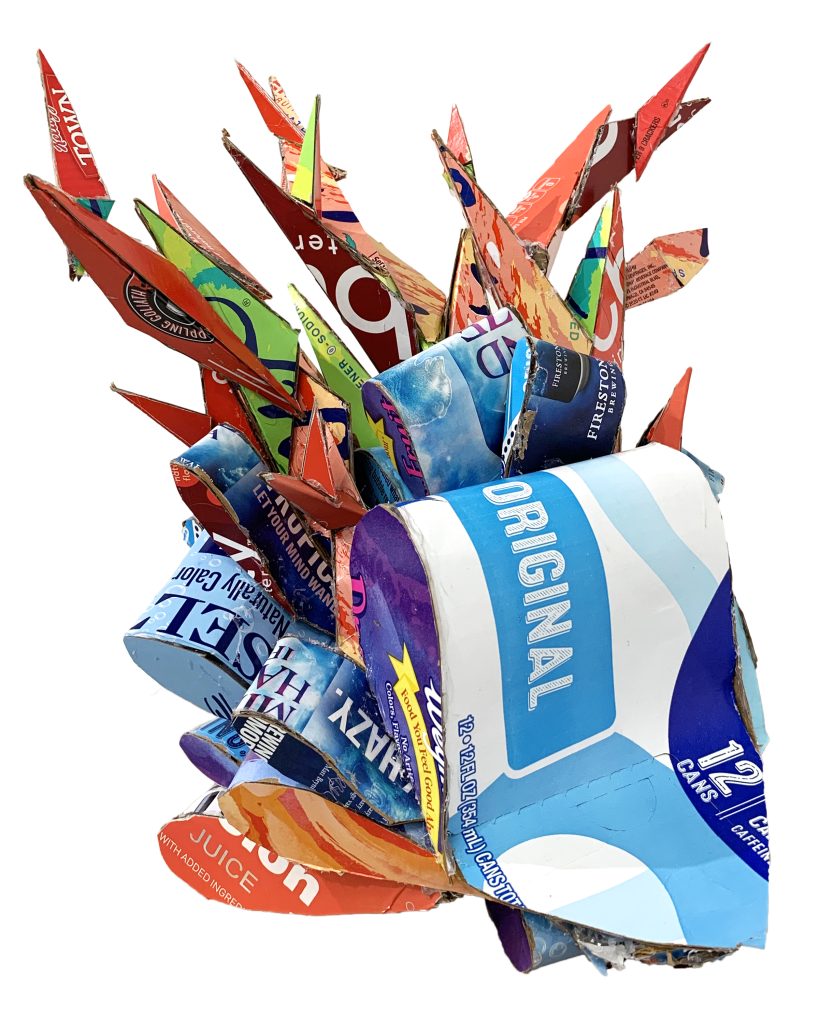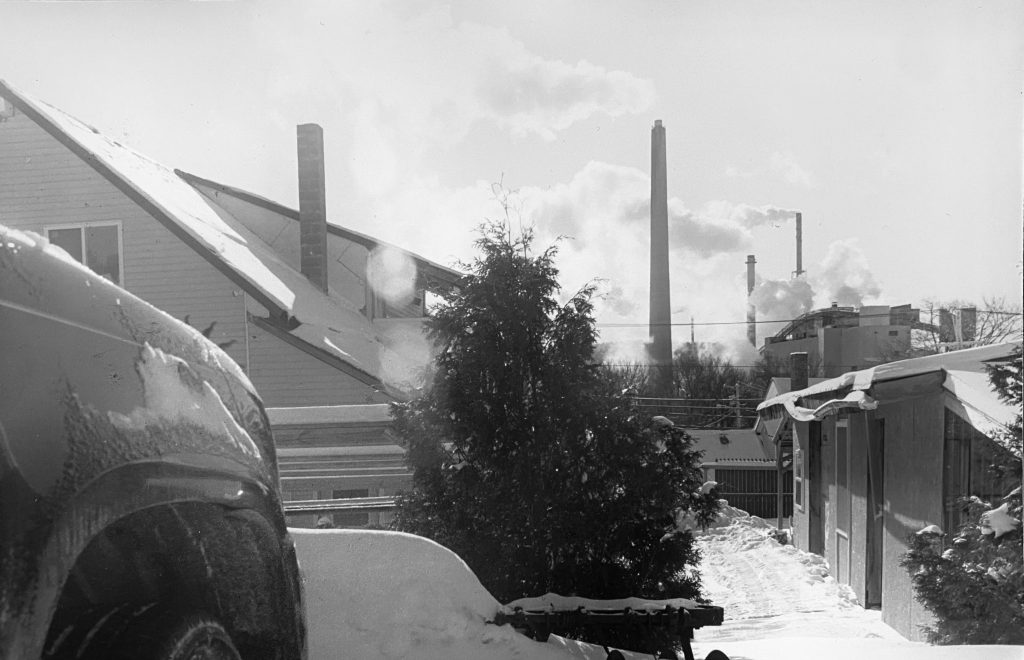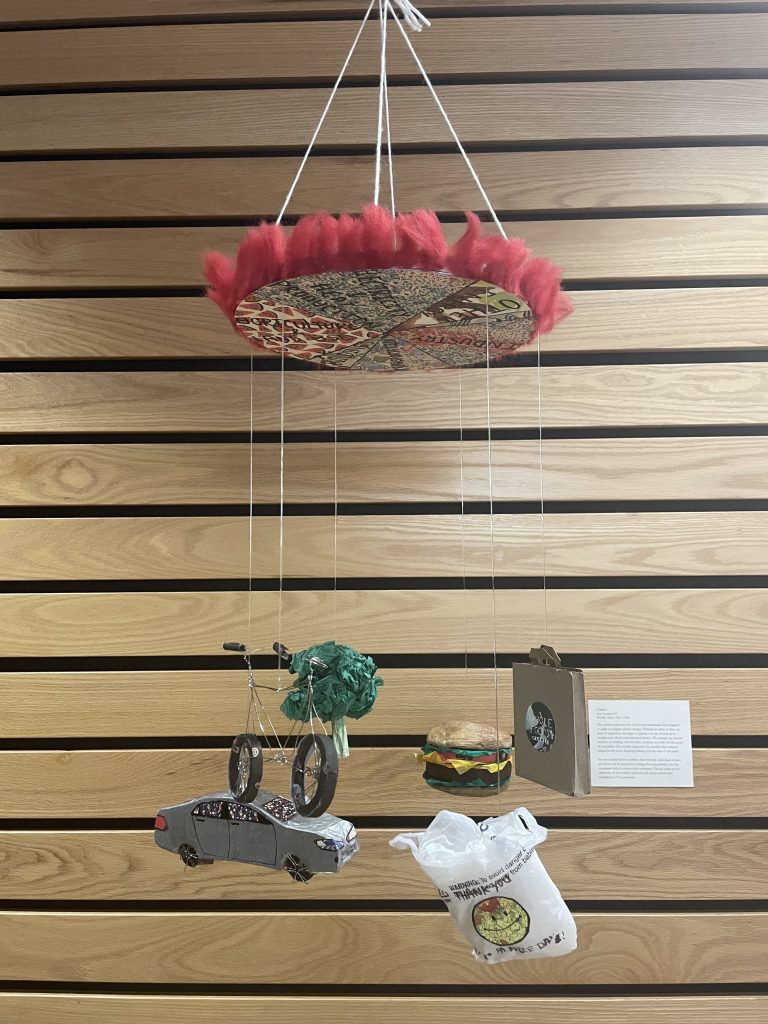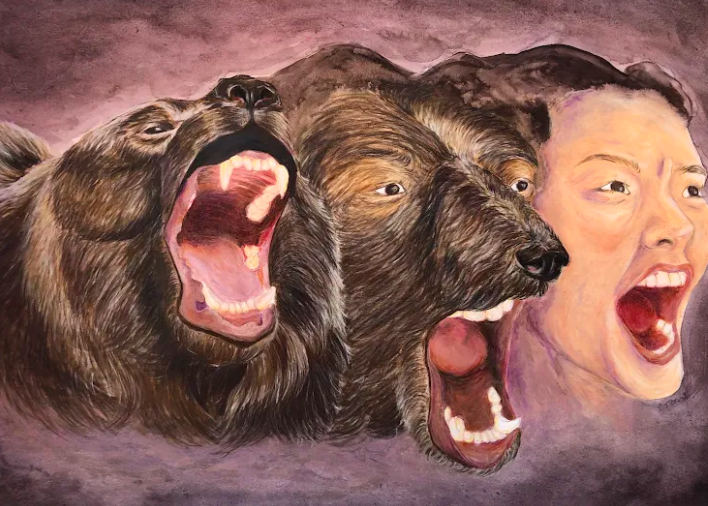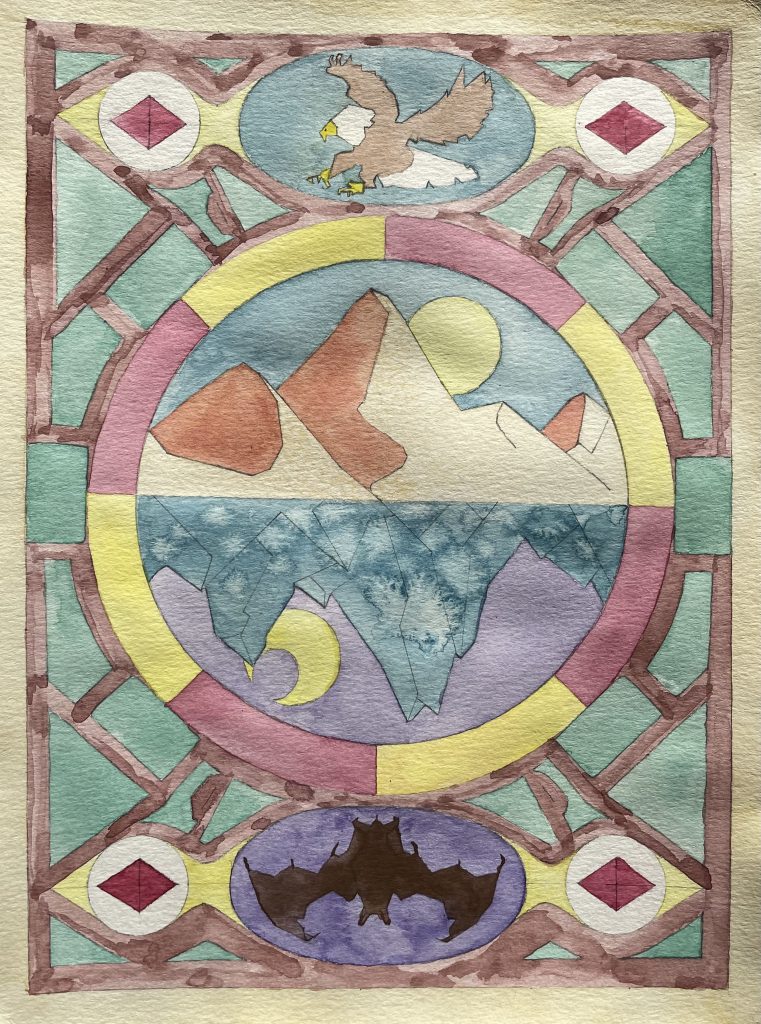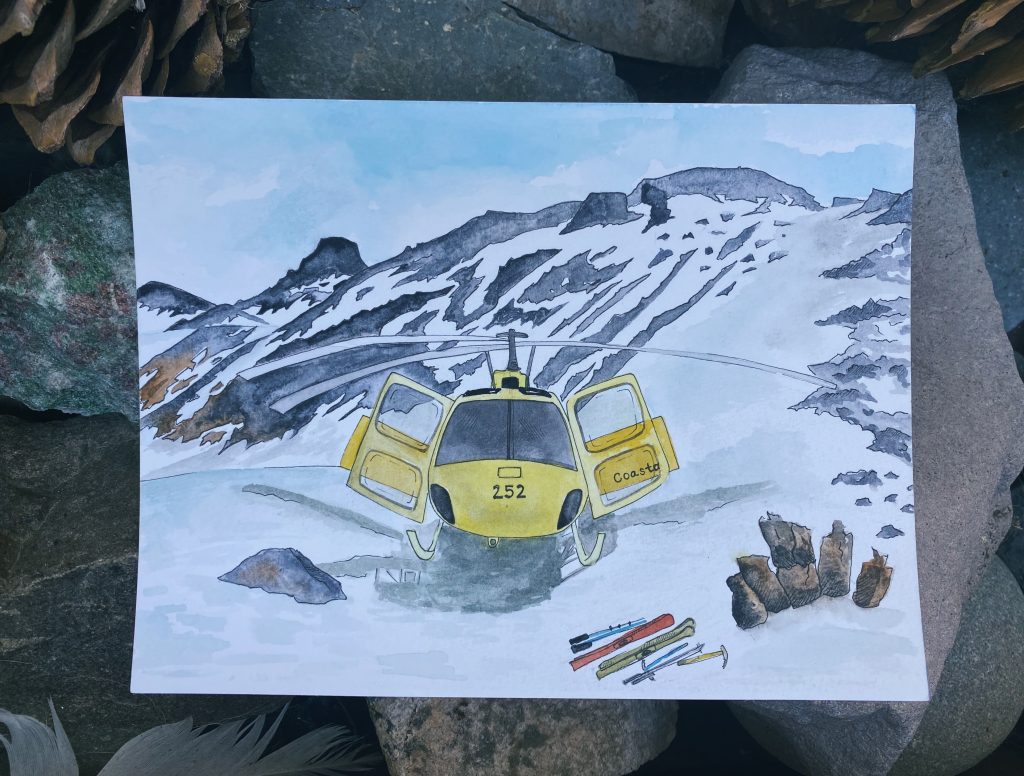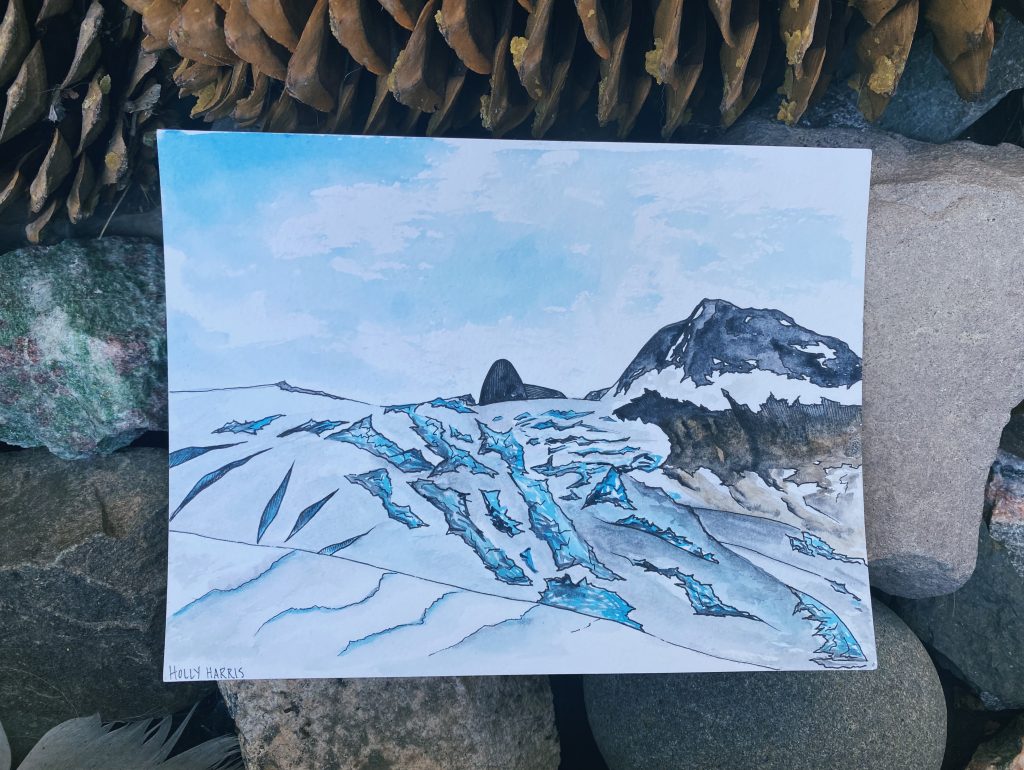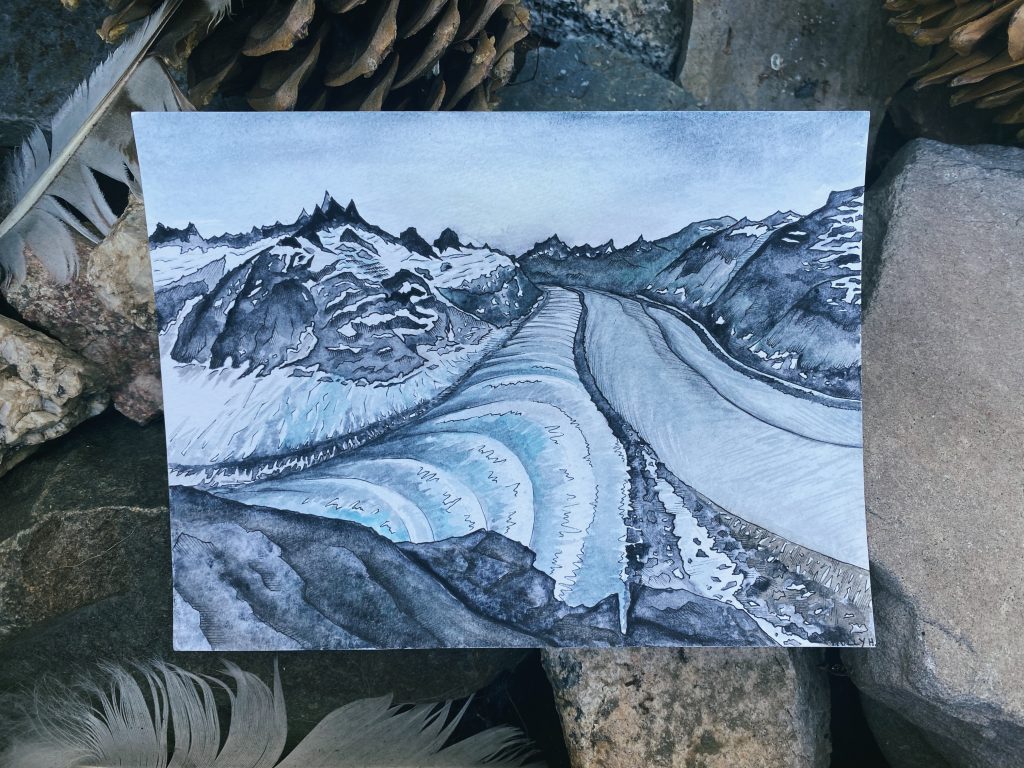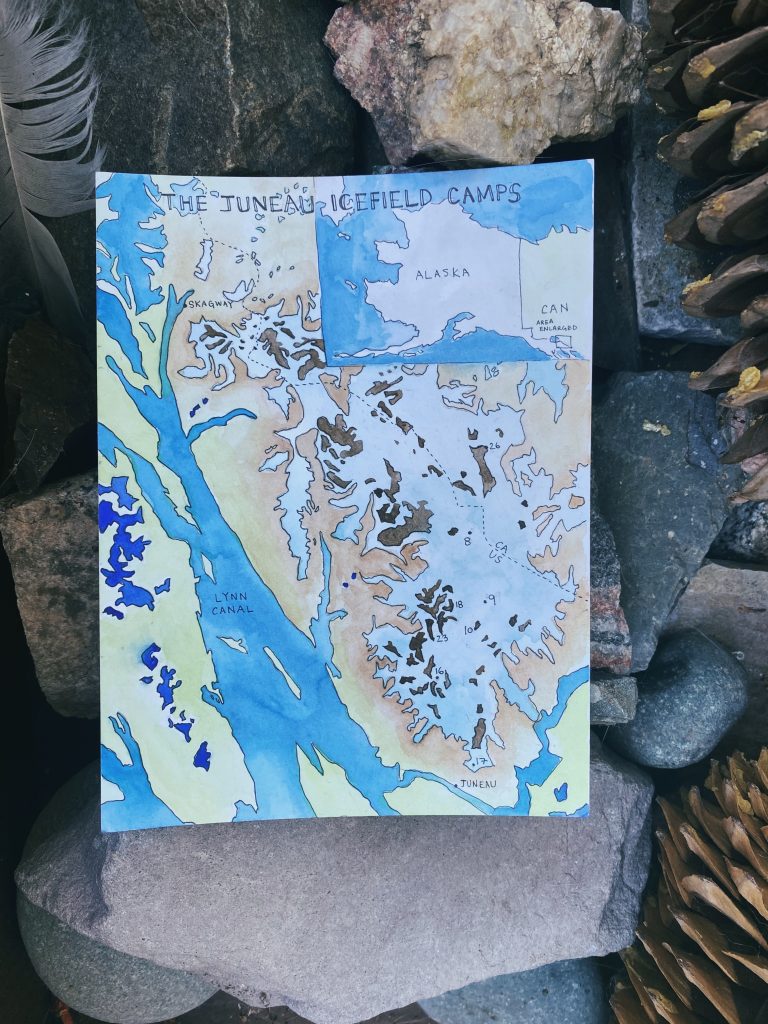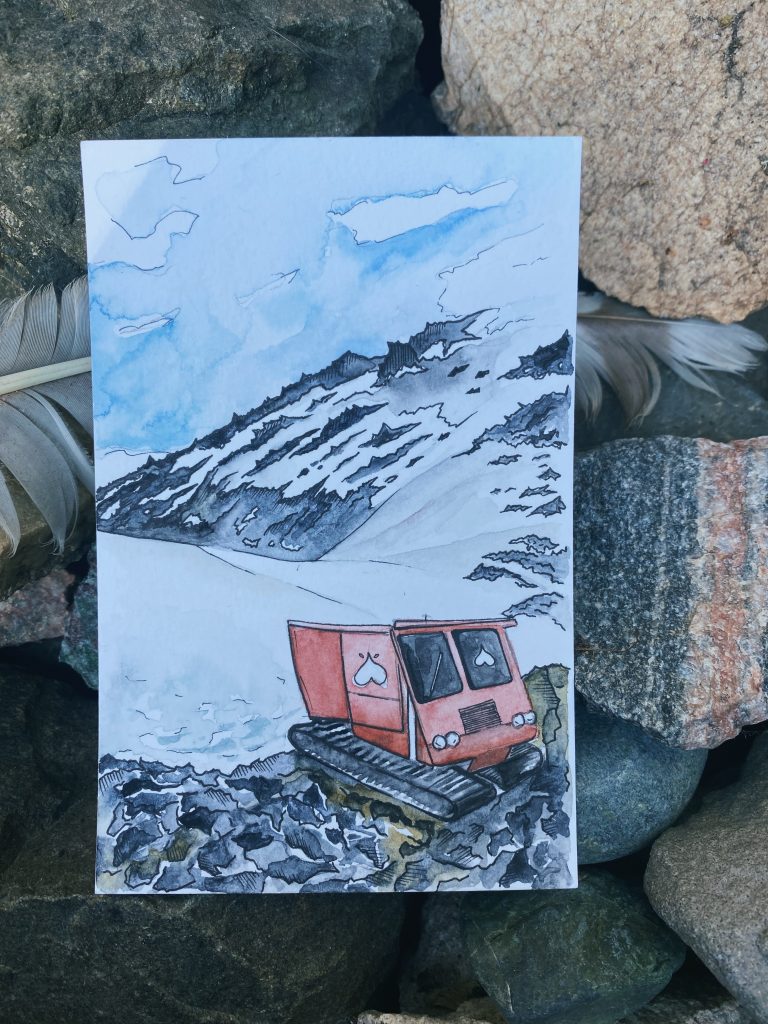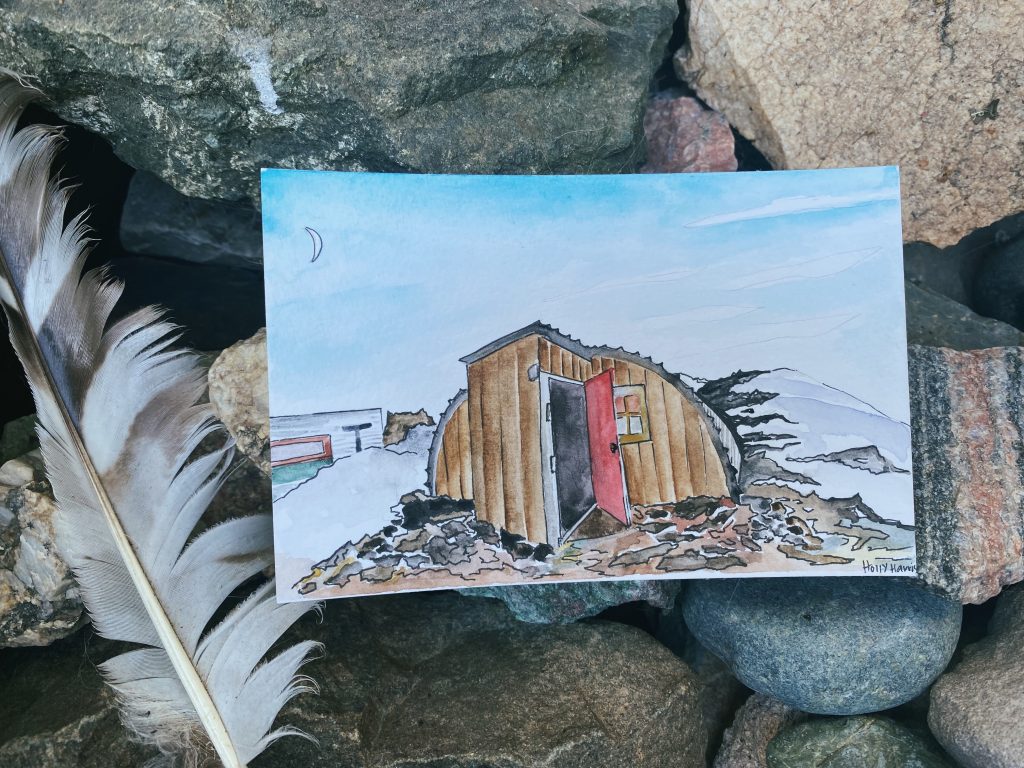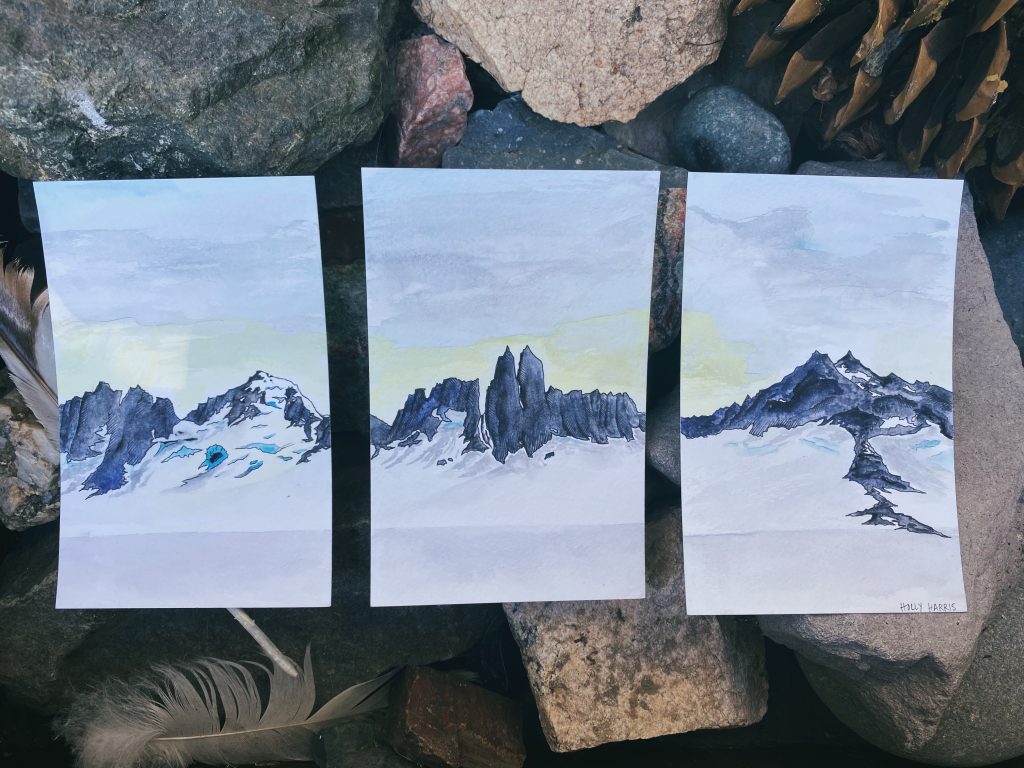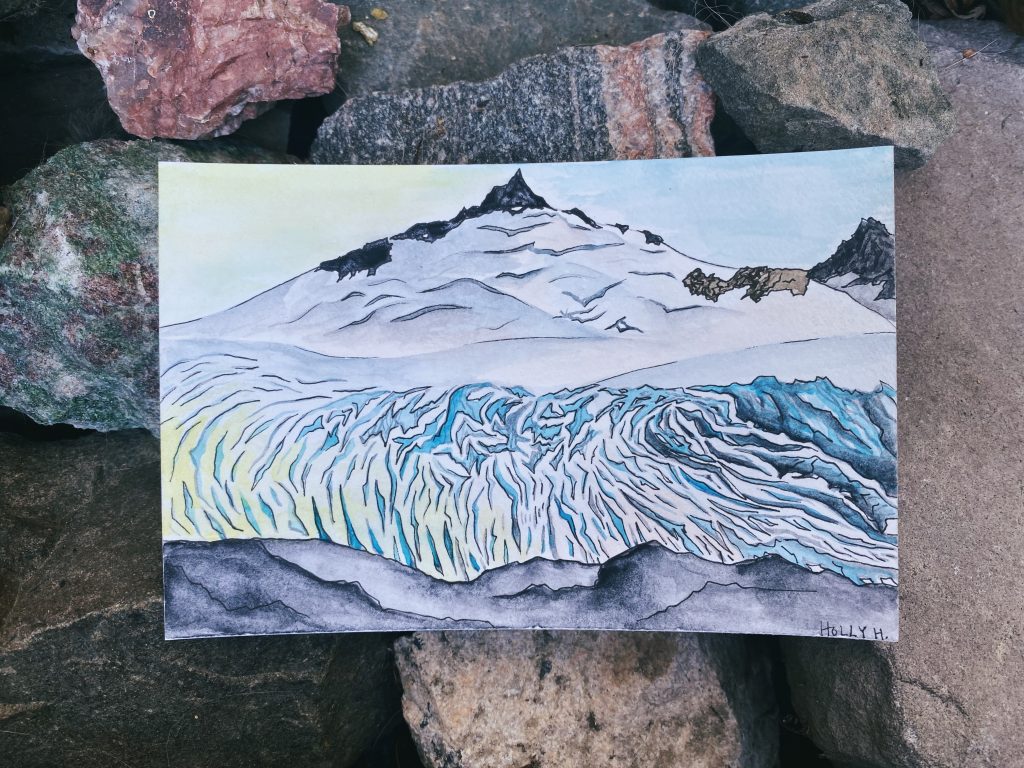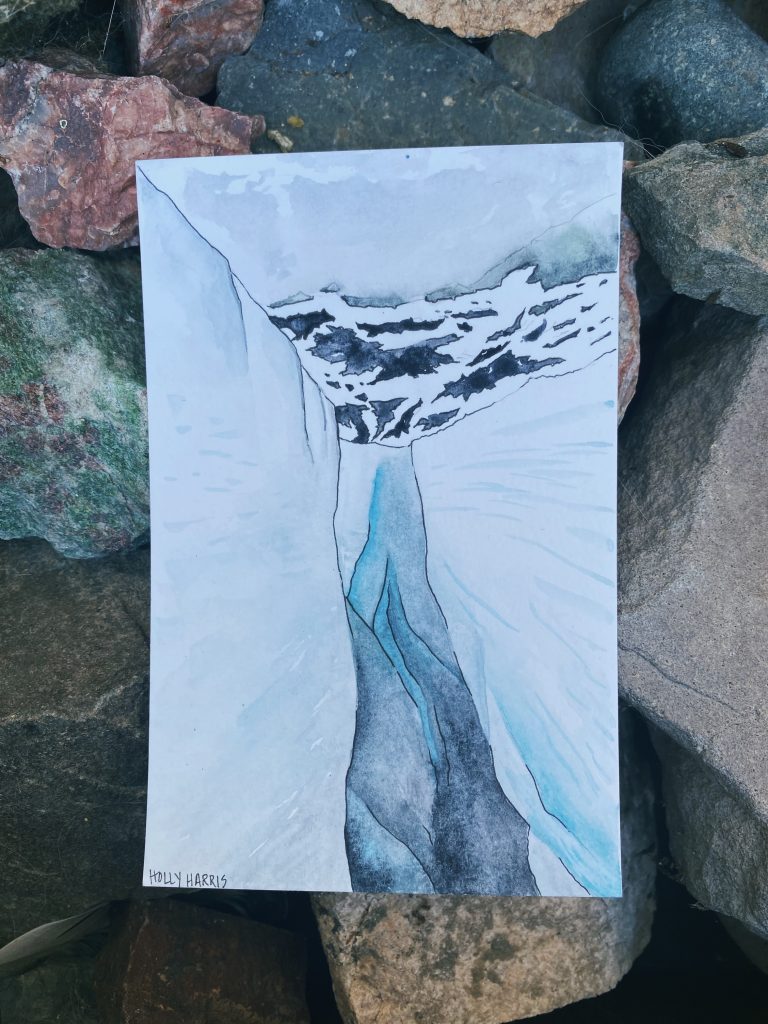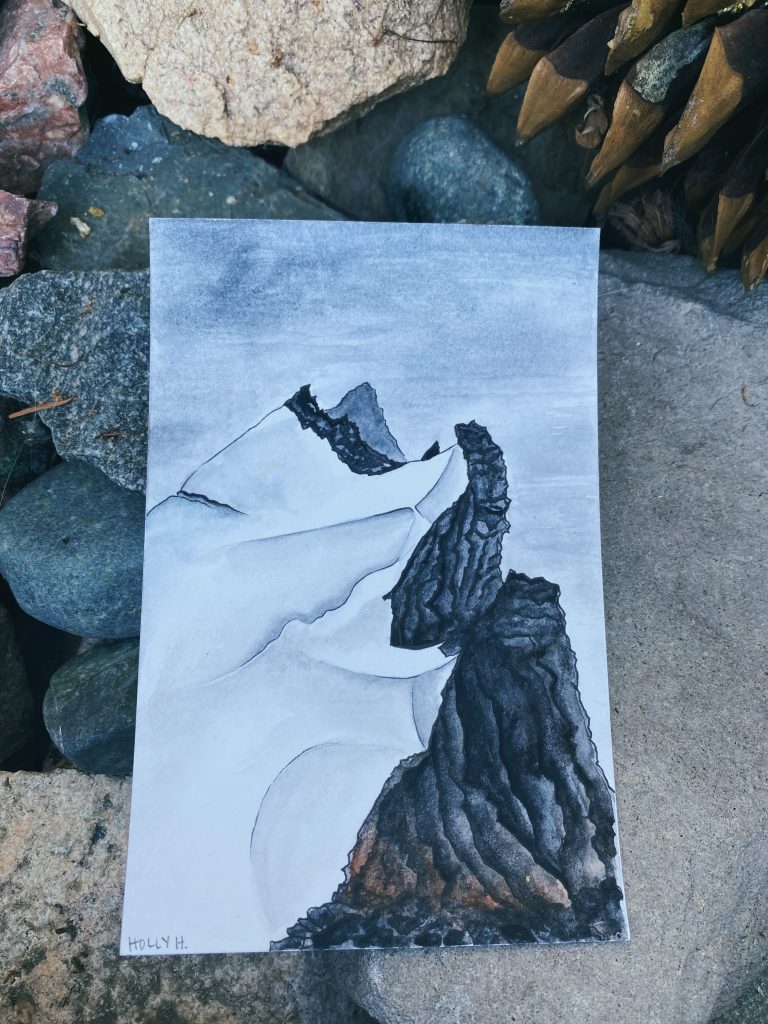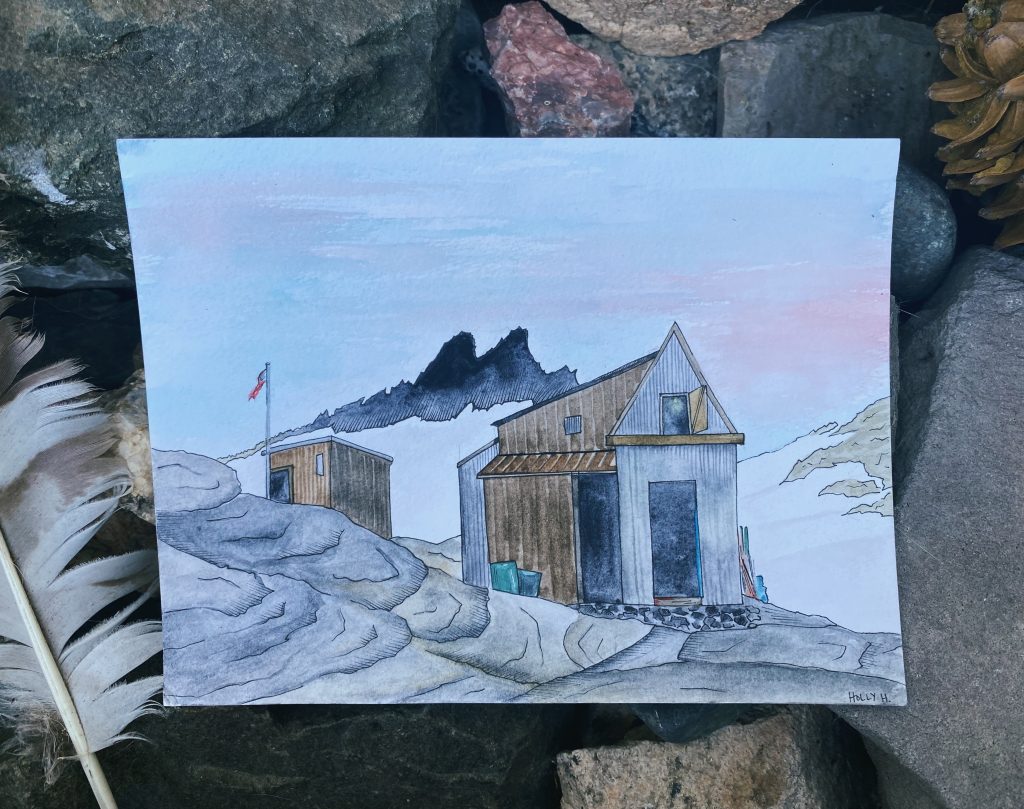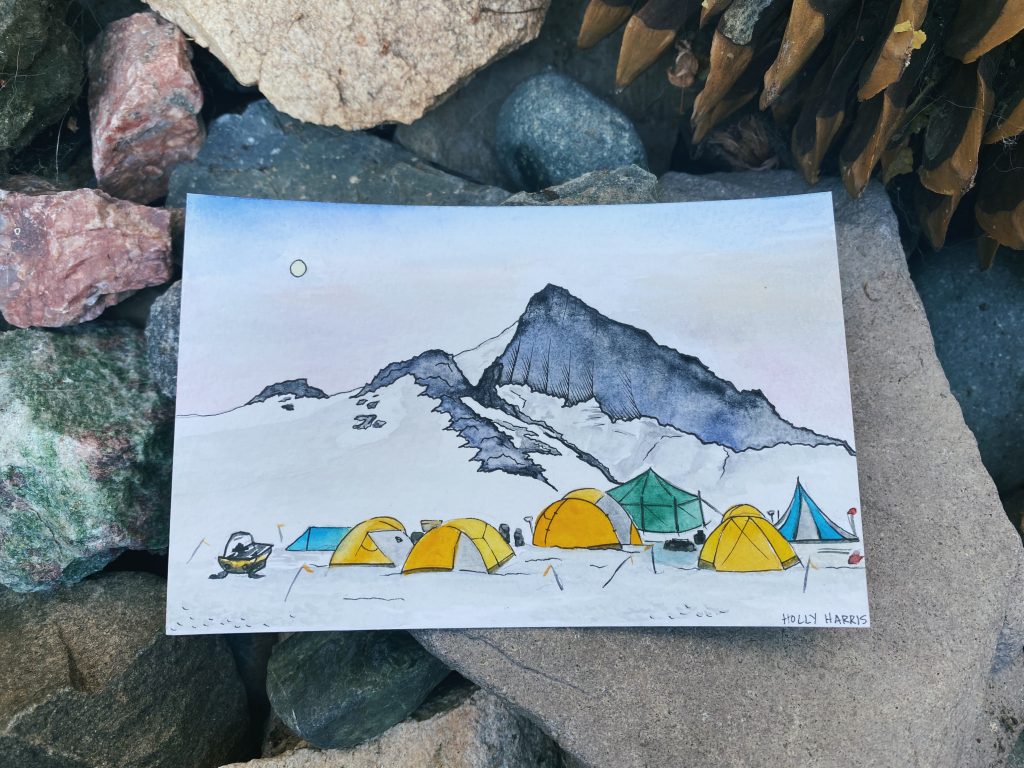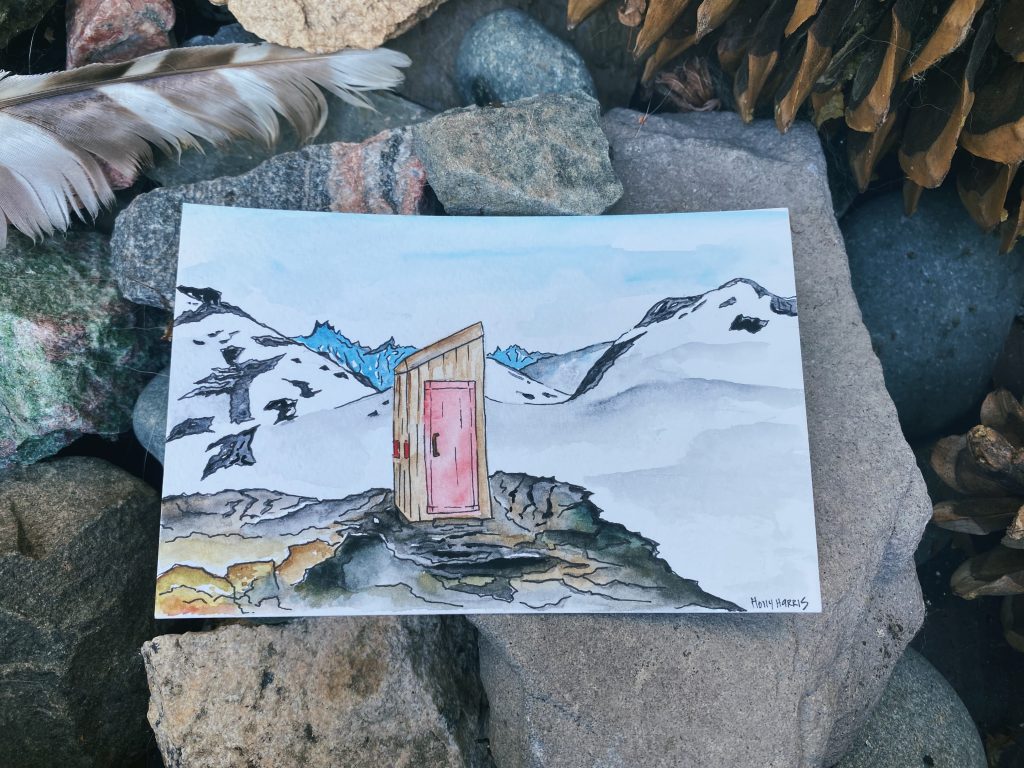Let Them Eat Cake
Anthea Bell ’22 and Matsu Hikida ’22
Plastic sculpture, photography, wig size: 10in x 15in x17in
In our piece, we used plastic and heat to make a wig and hoop skirt inspired by the French Rococo style during the late Baroque period, an era that was known for its excess and extravagance. Through invoking this period using plastic, we sought to critique the overproduction and overconsumption of manufactured goods—particularly of plastics— in our modern era and how it contributes to climate change and pollution. The inclusion of dumpsters in the background further contributes to the imagery of overconsumption and waste.
During the late Baroque period, the French aristocracy was able to indulge in luxuries while ignoring the poverty and plights of the poor. Thus, our piece also emphasizes how in our modern world, the wealthy disproportionally consumes goods and services that contribute to climate change and pollution, but the effects of climate change and pollution disproportionally affects the poor. Because the wealthy experience the consequences of climate change and pollution to a lesser degree, they have been hesitant to implement major changes to help solve climate change and pollution. This ultimately invokes the sentimentality of Marie Antionette’s infamous “Let them eat cake”.
Let’s Get Stuck In

Charlie O’Brien ’23
Prose Poem
I wrote this prose poem to explore the strengths and weaknesses of science in stimulating excitement and appreciation for the natural world. It is valuable in our climate crisis to embrace a mode of thinking that has as its urgent priority the goal of understanding phenomena or solving problems. As I wrote many of my beliefs and recent feelings came up, but I also try to get past myself to understand what needs to be done now to value our common future. At its heart the piece seeks to realign my personal values for the better. There’s gravity to our situation and I wanted that to push us further in questioning what is really important to us.
Decalcified
Katherine Page ’23
Acrylic on cardboard, 12in x 15in
Ocean acidification is a concerning threat to marine ecosystems and has climate change to blame. OA puts coastal resources at risk, decreasing calcification in organisms with CaCO3 shells or skeletons. Because the process of calcification itself also decreases pH, shifts in metabolic processes in response to OA could feed back to even more dramatic changes in coastal marine ecosystems. The effects of decalcification in marine organisms has not been thoroughly studied, but it is without a doubt that the loss of structure in organisms is harmful and could have a snowball effect for issues in our oceans.
My piece is a scene of colorful chaos dotted with monochrome mollusks. The mollusks are slowly deteriorating alongside a distracted and unknowing society.
Matricide
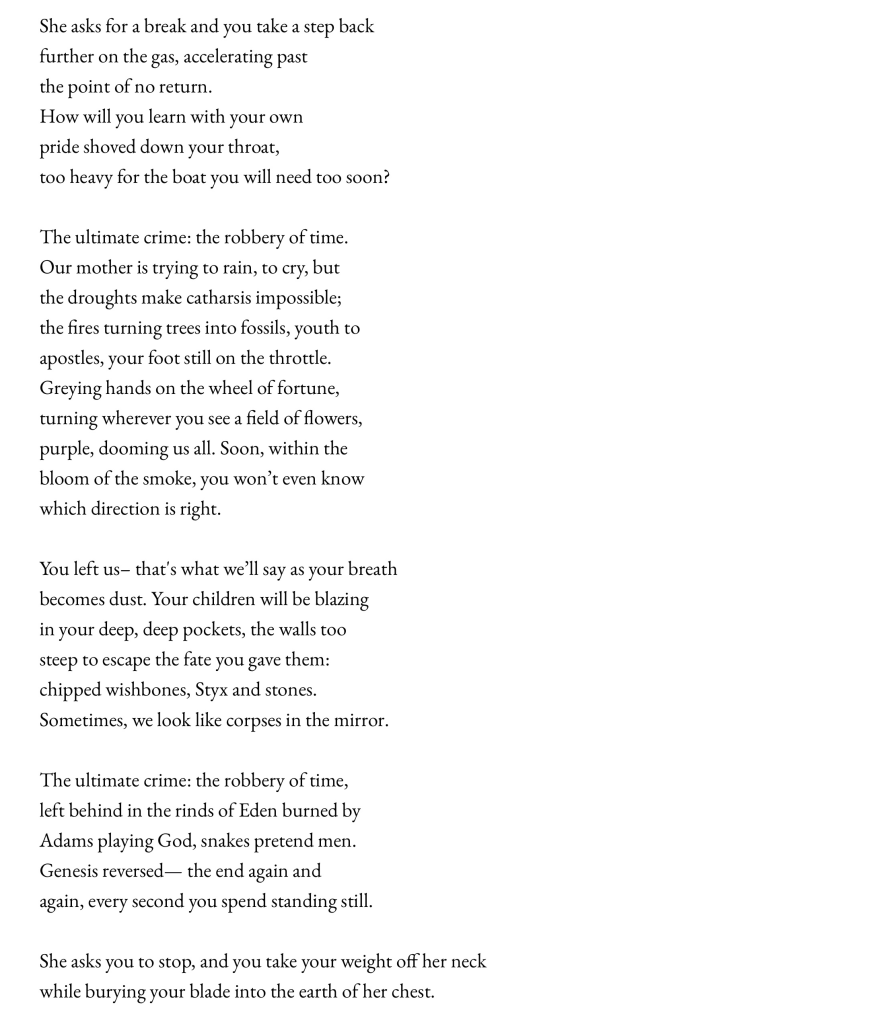
Dylan Richmond ’24
Poetry
Melt
Kate Padilla ’23
Acrylic on canvas, 12in x 16in
I wanted to create something that directly visually represents some of the changes happening in the world due to human action and decisions. In my experience, conversation on the melting ice caps, CO2 emissions, and pollution are increasingly common in my classes and in the news, so these were the first images that came to mind when thinking about this exhibition. In this painting, an iceberg melts into a vibrant swirling liquid, inspired by an exaggeration of an oil spill in the ocean. I created this piece with the hope that it explains my perception of how the environmental changes happening around us–exacerbated by us–are all irrevocably interconnected.
Flood & Fire
Anthea Bell ’22
Cardboard Sculpture, 12in x 10.5in x 14in
This piece depicts two types of natural disasters that have been occurring with increasing frequency in the past two years as a result of climate change— flash floods (e.g. the floods in Germany and China) and wildfires (e.g. record-setting fires in California, Colorado, and Australia). I wanted to contrast two extremes on opposite sides of the natural spectrum (water versus fire) to show how climate change can have seemingly contradictory effects in different regions of the globe that are nonetheless devastating. The use of cardboard from various food and drink containers further highlights the human influence that drives climate change, but also the human component that must be a part of the solutions to address it.
This work was also partially inspired by an audio sample from the song Anger by the artist Sleeping At Last. Thus, the jagged edges of the triangular forms and the overall wave-like shape of the sculpture invokes the feeling of anger and frustration toward the inaction of governing bodies and corporations (which can be represented by the graphics on the cardboard) as the consequences of climate change become more apparent.
Melting Away
Andria Polo Brizuela ’22
Photography, 11in x17in
Even after all we know, we keep suffocating our world until there will be nothing but pure white in our sight.
Choices
Ana Gunther ’23
Mobile, 10in x 10in x 16in
This mobile represents the choices that individuals feel obligated to make to mitigate climate change. Whether to drive or bike, eat meat or vegetables, use paper or plastic—we are all tied up in complicated ethical environmental choices. We assuage our climate anxieties by holding onto the little sacrifices we make for the good of our planet. The mobile represents the sacrifice that reduces emissions the most: forgoing children for the sake of the earth. No one should have to sacrifice their lifestyle. Individual choices get blown out of proportion, hiding the responsibility that big companies have to reduce their emissions. The pie chart on the underside of the mobile represents the major sectors that contribute to CO2 emissions.
Transgression
Elisabeth Chan ’25
Prismacolor, gouache, 16in x 12in
The divide between human and animal is rapidly decreasing. As climate change becomes a greater threat, all organisms experience the same peril, fear, displacement, and stresses of a world thrown into extremes. The animorph-style represents this conflation of species threats. The troubled emotions on the figures’ faces signifies their hardship.
May’s Goodbye
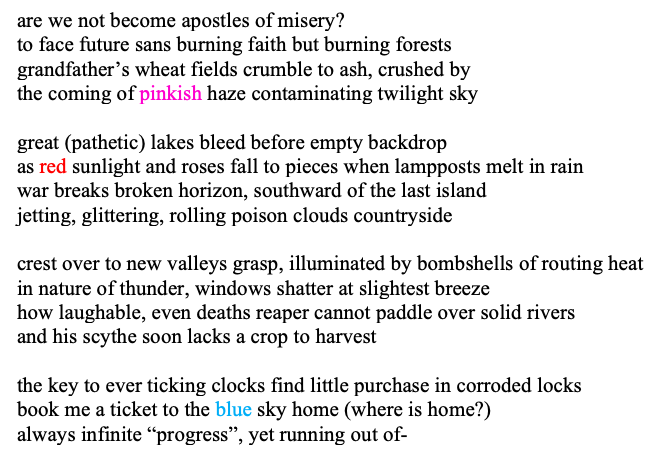
Ben Norwood ’25
Poetry
I intended to evoke strong imagery and convey that while supposed solutions have been tossed around for years regarding climate change, they have been ineffective. There is not enough work being done on a large enough and impactful scale to matter. Our future will look much like this poem if this continues.
Sun and Moon
Bennett Donahue ’24
Watercolor, 9in x13in
Sun and Moon reflects the different realities our choices can create. It’s made using simple materials, muted colors, and natural imagery.
Apples breathing, fading
Matsu Hikida ’22
Video
The piece in the time lapse is made out of freshly peeled apple peels, apple peels that had already been left out for a few days, and styrofoam packing peanuts hammered and glued together to create an apple-peel-like shape. The fresh apple peels gently rotted away even while I was placing them, obvious when observed at certain key intervals but difficult to see in the moment. This “melting” effect of the decomposing apple peels is very clear on the time-lapse. Similarly, are rarely willing to observe the negative effects of the climate crisis, and thus let our world rot away from us. Meanwhile, the styrofoam and the pre-melted apple peels hold relatively steady. The styrofoam is synthetic but the older apples are not, showing hope for the future with sustainable designs and solutions.
Field Sketches from Juneau Ice Field
Holly Harris ’22
15 watercolors, 5in x7in
I spent this past summer on the Juneau Icefield conducting research on the Taku glacier, the deepest and thickest alpine glacier in the world. My time on the ice field reiterated for me a fascination and appreciation for earth’s many intricate, interconnected and fragile systems. It was incredible to witness firsthand the scale and speed at which glacial retreat is occurring due to climate change. The landscape and experience was truly otherworldly and one that will inevitably drastically evolve in my lifetime. It felt important, as both a means of connection and documentation, for me to take the time each day to work on my field sketches. Each of these little pieces carries with it specific memories and newfound understandings for ways to consider our climate. I fear not only for the change I will see on the ice field, a place that now holds a special place in my heart, but the implications of glacial melt on all alpine glaciers and most crucially, at our poles.
a Scream in Color, a Funeral in White
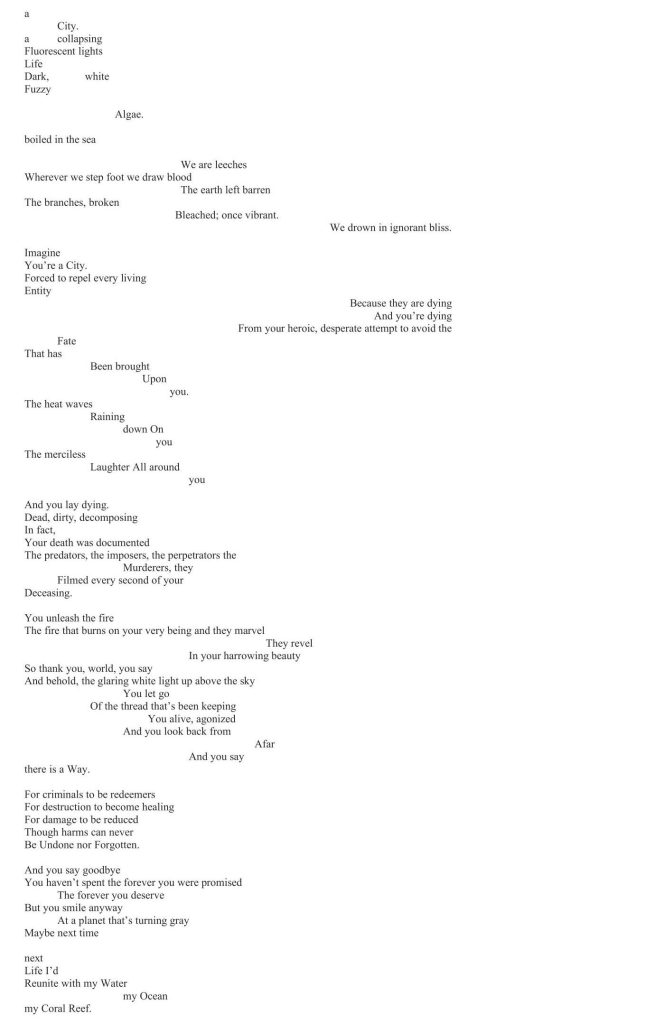
K Zhan ’25
Spoken word poetry
Snap Streaks
Tor Parker ’21
Film photograph
Sometimes a statement is obvious. There is a metaphor to be found in these photographs, images of the Androscoggin river corroded by my amateur film-processing failures. This roll was the first I had ever developed on my own. As I sat in the dark room my inexperienced fingers roughly coiled the film strip around the metal reel, causing sections of the film to crease on itself. The areas where this occurred became, in turn, inaccessible to the processing chemicals, creating indiscriminate streaks of white in the negatives. I originally thought very little of my error. I would simply avoid enlarging, or printing, the negatives that had been corrupted. Yet when this exhibition was announced, I was immediately drawn to this set of images. The irony, the metaphor, the meaning, the message in these images is nothing extraordinary. It is relatively plain to see: there are three images of nature that have been mutilated by my mistakes in the dark room. I invite you all to make the small leap between how the chemicals and human error that tampered with these images of nature relates to the reality of climate change. Yet despite how obvious it is, how clear our role stands in the destruction of our planet, we still seem unable to mobilize. Unless we begin to act, these metaphoric streaks will only grow in size and scale.
Wind Winding Woman
Alexis Mullen ’23
Modern Dance (improvisational, free movement)
Climate change is usually discussed with great urgency and insistence; “act now or forever ruin our planet.” “Even though you weren’t the one to start this mess, fix it NOW!” I carry that anxiety with me in my body, as do many others I know.
I fell in love with nature and the earth later in life than I probably should have – at age 19 – during my oceanography class at Bowdoin. I was so amazed by this planet and its incredible interconnectedness. I started being able to consciously appreciate the nature around me and explored healing through being outside.
I dance to connect at a deeper level with the earth and myself. In my choreography class we talk about dancing and noticing and then dancing again; I’ve started seeing that trees and water and other facets of nature incorporate themselves in my movements. The earth and I are moving together in harmony and my anxieties are beginning to dissolve a bit.
My response to climate change is to call nature a (best) friend. Let’s not forget to enjoy the beauty of this earth while we are also fighting to save her future. My piece “Wind Winding Woman” focuses on my relationship to wind and my family farm in Iowa that rests on Báxoje Máya (Ioway) and Ochethi Sakówin (Sioux) land. The piece features sweet moments of dancing at sunset and walking my dog Lucy around the cornfields. The soundtrack incorporates windmill sounds and beanstalk crunching.
